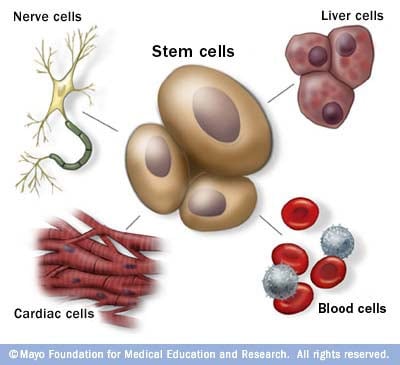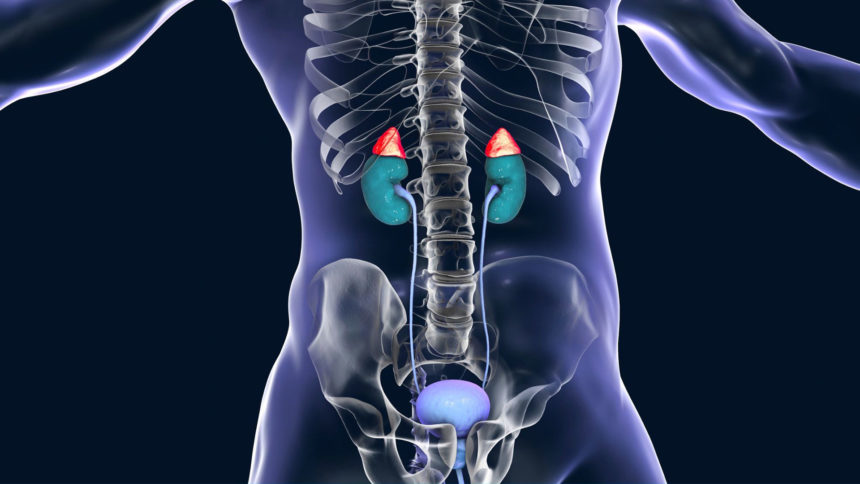Stem cells offer great promise for new medical treatments. Learn about stem cell types, current and possible uses, and the state of research and practice. By Mayo Clinic Staff
You’ve heard about stem cells in the news, and perhaps you’ve wondered if they might help you or a loved one with a serious disease. You may wonder what stem cells are, how they’re being used to treat disease and injury, and why they’re the subject of such vigorous debate.
Here are some answers to frequently asked questions about stem cells.
What are stem cells?
 Open pop-up dialog box
Open pop-up dialog box
Stem cells: The body’s master cells
Stem cells are the body’s raw materials — cells from which all other cells with specialized functions are generated. Under the right conditions in the body or a laboratory, stem cells divide to form more cells called daughter cells.
These daughter cells become either new stem cells or specialized cells (differentiation) with a more specific function, such as blood cells, brain cells, heart muscle cells or bone cells. No other cell in the body has the natural ability to generate new cell types.
Why is there such an interest in stem cells?
Researchers hope stem cell studies can help to:
- Increase understanding of how diseases occur. By watching stem cells mature into cells in bones, heart muscle, nerves, and other organs and tissue, researchers may better understand how diseases and conditions develop.
- Generate healthy cells to replace cells affected by disease (regenerative medicine). Stem cells can be guided into becoming specific cells that can be used in people to regenerate and repair tissues that have been damaged or affected by disease.People who might benefit from stem cell therapies include those with spinal cord injuries, type 1 diabetes, Parkinson’s disease, amyotrophic lateral sclerosis, Alzheimer’s disease, heart disease, stroke, burns, cancer and osteoarthritis.Stem cells may have the potential to be grown to become new tissue for use in transplant and regenerative medicine. Researchers continue to advance the knowledge on stem cells and their applications in transplant and regenerative medicine.
- Test new drugs for safety and effectiveness. Before using investigational drugs in people, researchers can use some types of stem cells to test the drugs for safety and quality. This type of testing will most likely first have a direct impact on drug development for cardiac toxicity testing.New areas of study include the effectiveness of using human stem cells that have been programmed into tissue-specific cells to test new drugs. For the testing of new drugs to be accurate, the cells must be programmed to acquire properties of the type of cells targeted by the drug. Techniques to program cells into specific cells are under study.For instance, nerve cells could be generated to test a new drug for a nerve disease. Tests could show whether the new drug had any effect on the cells and whether the cells were harmed.
Where do stem cells come from?
There are several sources of stem cells:
- Embryonic stem cells. These stem cells come from embryos that are 3 to 5 days old. At this stage, an embryo is called a blastocyst and has about 150 cells.These are pluripotent (ploo-RIP-uh-tunt) stem cells, meaning they can divide into more stem cells or can become any type of cell in the body. This versatility allows embryonic stem cells to be used to regenerate or repair diseased tissue and organs.
- Adult stem cells. These stem cells are found in small numbers in most adult tissues, such as bone marrow or fat. Compared with embryonic stem cells, adult stem cells have a more limited ability to give rise to various cells of the body.Until recently, researchers thought adult stem cells could create only similar types of cells. For instance, researchers thought that stem cells residing in the bone marrow could give rise only to blood cells.However, emerging evidence suggests that adult stem cells may be able to create various types of cells. For instance, bone marrow stem cells may be able to create bone or heart muscle cells.This research has led to early-stage clinical trials to test usefulness and safety in people. For example, adult stem cells are currently being tested in people with neurological or heart disease.
- Adult cells altered to have properties of embryonic stem cells. Scientists have successfully transformed regular adult cells into stem cells using genetic reprogramming. By altering the genes in the adult cells, researchers can reprogram the cells to act similarly to embryonic stem cells.This new technique may allow use of reprogrammed cells instead of embryonic stem cells and prevent immune system rejection of the new stem cells. However, scientists don’t yet know whether using altered adult cells will cause adverse effects in humans.Researchers have been able to take regular connective tissue cells and reprogram them to become functional heart cells. In studies, animals with heart failure that were injected with new heart cells experienced improved heart function and survival time.
- Perinatal stem cells. Researchers have discovered stem cells in amniotic fluid as well as umbilical cord blood. These stem cells have the ability to change into specialized cells.Amniotic fluid fills the sac that surrounds and protects a developing fetus in the uterus. Researchers have identified stem cells in samples of amniotic fluid drawn from pregnant women for testing or treatment — a procedure called amniocentesis.
Why is there a controversy about using embryonic stem cells?
Embryonic stem cells are obtained from early-stage embryos — a group of cells that forms when eggs are fertilized with sperm at an in vitro fertilization clinic. Because human embryonic stem cells are extracted from human embryos, several questions and issues have been raised about the ethics of embryonic stem cell research.
The National Institutes of Health created guidelines for human stem cell research in 2009. The guidelines define embryonic stem cells and how they may be used in research, and include recommendations for the donation of embryonic stem cells. Also, the guidelines state that embryonic stem cells from embryos created by in vitro fertilization can be used only when the embryo is no longer needed.


Leave a Reply
You must be logged in to post a comment.